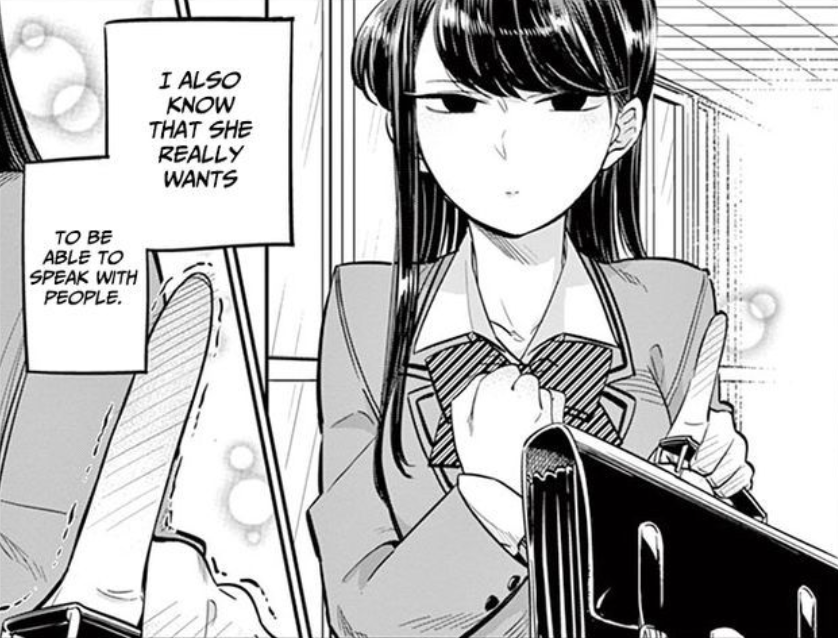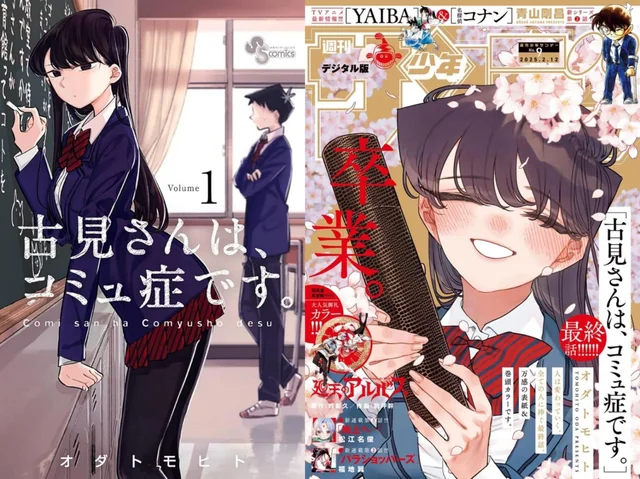This review of Komi Can’t Communicate explores the bittersweet yet heartwarming journey of Shoko Komi, a girl admired for her beauty but secretly paralyzed by social anxiety. With the help of her classmate Tadano, she sets out on a mission to make one hundred friends a premise that blends comedy, vulnerability, and school life charm. From eccentric classmates to moments of quiet sincerity, the manga captures both the struggles and triumphs of human connection.
Komi Can’t Communicate Review: When Silence Speaks Louder Than Words
When I first picked up Komi Can’t Communicate on ComicK, I expected a fluffy high school comedy. What I found instead was something far more relatable: a story about the invisible walls we build around ourselves and the courage it takes to break them. Shoko Komi isn’t just the “perfect class princess” she’s a girl who freezes at the thought of saying “hello.” And honestly, who hasn’t felt that way at some point?
What makes this manga shine is the way it takes such a simple idea wanting to make friends and turns it into something both hilarious and painfully human. Komi’s journey resonates with anyone who has ever sat in a classroom feeling like everyone else had life figured out. Through awkward silences, exaggerated misunderstandings, and the gentle kindness of Tadano, her story pulls you in before you even realize you’ve started rooting for her.

As someone who has read more slice-of-life manga than I can count, I’ll admit that Komi Can’t Communicate isn’t perfect. But that imperfection the messy way Komi grows, the uneven pace of the story feels authentic. It’s a reminder that friendship doesn’t come neatly packaged; it’s chaotic, funny, and sometimes frustrating.
The Charm of Shoko Komi
Shoko Komi is introduced as the kind of girl everyone admires: beautiful, composed, and untouchable. Yet behind her calm expression is a storm of anxiety that makes even the simplest words impossible. This duality is what makes her so endearing. She’s not flawless she’s fragile, and that fragility is her strength.
Reading Komi’s struggle reminded me of how easily we misunderstand people. Her silence is mistaken for confidence, her wide eyes for intensity, and her hesitation for aloofness. In truth, she just wants to connect. It’s heartbreaking and relatable all at once.
What sets Komi apart from other manga heroines is how her story doesn’t rely on dramatic romance or over-the-top plot twists. Instead, it focuses on small, human moments: writing on a chalkboard, standing in line with a friend, or simply sitting in silence without feeling judged. Those quiet panels hit harder than any shouting match could.
Tadano: The Unsung Hero
If Komi is the heart of the story, Tadano is the bridge. At first glance, he’s ordinary almost forgettable but that’s exactly why he matters. Tadano notices what no one else does. He sees Komi’s struggle, not her façade, and decides to help without making her feel broken.
His role isn’t to “fix” Komi, but to walk beside her. That distinction is important. Too often in manga, one character’s flaw becomes another’s responsibility. But Tadano’s gentle patience feels genuine. He listens, adapts, and creates space for Komi to grow at her own pace.
Their relationship isn’t built on dramatic confessions or forced romantic beats it’s rooted in trust. And that’s refreshing. Sometimes, the most powerful connections are the quiet ones, where simply being present speaks volumes.
The Eccentric Classmates
Of course, no school-life manga is complete without a cast of quirky side characters. From Najimi, the extrovert who knows everyone, to Yamai, whose obsession borders on absurd, the classmates add layers of comedy and chaos. Each encounter pushes Komi a little further outside her comfort zone.
But here’s the tricky part: while these characters bring energy, they sometimes feel shallow. Their quirks are entertaining, but not always developed beyond the joke. As a reader, I found myself wishing for more depth moments that showed who they were beyond the punchlines.
That said, they serve their purpose. Komi’s social circle expands because of them, and every bizarre interaction is a reminder that friendship isn’t about finding “perfect” people it’s about finding people who stick around, even when things get awkward.
The Humor: Hit or Miss
Comedy is at the heart of Komi Can’t Communicate, and when it works, it’s delightful. Komi’s exaggerated reactions, Najimi’s antics, and the constant misunderstandings make for laugh-out-loud moments. There’s a charm in the absurdity that fits perfectly with the high school setting.
Yet, not every joke lands. Some situations stretch believability so far that they lose impact like characters mistaking Komi for a terrifying figure capable of tearing limbs off. While intended as comedy, these extremes can feel disconnected from the emotional core of the story.
Still, the humor is balanced by sincerity. For every over-the-top gag, there’s a quiet scene where Komi takes a tiny step forward. Those contrasts keep the story from being just another slapstick comedy.

Artwork: A Mixed Bag
The art in Komi Can’t Communicate is both its strength and its weakness. On one hand, Komi’s design wide eyes, elegant posture, subtle expressions captures her character beautifully. On the other, the exaggerated comedic panels can sometimes clash with the tone, making certain moments harder to take seriously.
But when the artwork gets it right, it’s stunning. Simple, wordless panels often carry the most weight. A single close up of Komi’s trembling hands or hesitant smile can speak louder than a page of dialogue. That ability to convey emotion through silence is what makes the manga special.
It’s not flawless, but maybe that’s the point. Just like Komi herself, the art doesn’t always “say” what it means directly. You have to lean in, pay attention, and read between the lines.
Who Should Read Komi Can’t Communicate?
Komi Can’t Communicate isn’t for everyone. If you’re looking for a tightly plotted story with deep character arcs, you may find it frustrating. But if you enjoy slice-of-life storytelling, awkward comedy, and the slow, tender process of building connections, this manga will feel like a warm cup of tea on a quiet afternoon.
For me, reading it on ComicK was both comforting and nostalgic. It reminded me of the quiet struggles I’ve faced, the times I’ve sat in silence wishing I could just say something. And it reminded me of the people who, like Tadano, patiently waited for me to find my words.
In the end, that’s what makes Komi Can’t Communicate worth reading. It’s not about perfection it’s about progress. And sometimes, that’s the most relatable story of all.
Read more:
- Review Rascal Does Not Dream of Bunny Girl Senpai
- Fly Me to the Moon Review Explore Cute Newlywed Adventures
